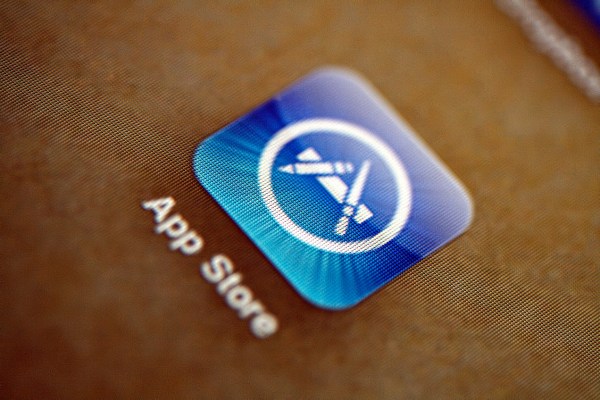To keep the playing field level and fair for all app developers, Apple on occasion changes the way its App Store ranking algorithm works, the fallout of which can impact developers’ standings in the App Store charts, which ultimately can impact their visibility, downloads, and revenue. Around a week ago, it appears that Apple yet again tweaked the way its rankings worked, but this time around, the changes have only impacted a subset of iPad app developers in the U.S. App Store.
No one knows the specifics of how Apple’s App Store ranking algorithm works, but it’s generally understood to take into account factors like download volume, velocity, and possibly other metrics like ratings or engagement.
There are a number of ways to spot a possible rankings change, but one of the easiest is to keep an eye on the rankings of top mobile apps, like Facebook and others. Because of the size and reach of these applications, a significant movement of these apps in the App Store charts can indicate that Apple could be making adjustments to how apps are weighted.
Of course, those changes can also just point to a rankings glitch, so the only way to determine if the App Store algorithm has actually changed is to survey the market in the days that follow to see if developers are seeing major changes following a sudden drop or spike in their rankings.
Beginning on Friday, July 17, something odd happened with Apple’s App Store rankings.
Yes. something has happened. but what? pic.twitter.com/eLBc2SuvJJ
— Ouriel Ohayon (@OurielOhayon) July 22, 2015
Facebook’s iPad app offers a good example of the change, as its app moved from a No. 2 position in “Social Networking” and a No. 7 ranking “Overall” the day before, down to No. 4 and No. 24, respectively, on Friday, and then it crashed to No. 38 in “Social Networking” and a practically invisible No. 858 “Overall” by Monday.
The app’s download ranking has since begun climbing back up, reaching No. 2 again in “Social Networking,” and No. 9 “Overall” by mid-week.
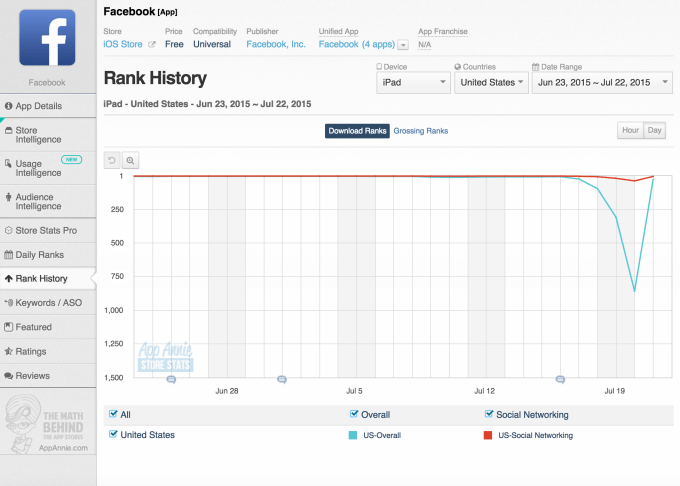
However, not all developers saw their rankings recover similarly, which is the most telling sign that this could be more than “just a glitch.”
Another indicator of an App Store algorithm change involves looking at the top mobile apps on the App Store and checking their ranking for particular keywords. If you see that there’s been a dramatic change in the keywords they rank for, then it’s a good indicator that there has been an algorithm change (presuming, of course, there hadn’t been an app update that caused the fluctuation.)
You can see in a number of top apps, including Facebook, Twitter, Instagram, Minecraft, YouTube and Snapchat, that there was a very large change that impacted the keyword rankings beginning on July 17. (See below.)
[gallery ids="1187265,1187264,1187260,1187262,1187263,1187266"]
The question on many developers’ minds after seeing a massive drop in their rankings followed by a subsequent climb back up the charts was if this change was merely an App Store bug or if Apple had made a longer-lasting adjustment.
We reached out to mobile marketing firm Fiksu, which confirmed that it had also observed non-standard App Store behavior beginning last Friday that affected iPad rankings over the course of several days.
“The apps that dropped have jumped significantly back up today,” noted Fiksu’s Chief Strategy Officer, Craig Palli on Wednesday, “but not all of them have returned to the ranks that they were at before the drop started on Friday,” he says. While he noted that the company is still investigating, as of now, it appears to be consistent with historical ranking protocol changes.
iPad Category Rankings Most Affected
In addition, in speaking with well over a dozen app developers about their individual experiences following their iPad apps’ crash in the App Store charts, we learned that a majority did see a massive drop in the charts beginning on Friday, mostly with regard to their Category rankings.
Those who claimed they weren’t affected, in some cases only had an iPhone application (which works on iPad, but is not a true iPad app), or described their app as being “low volume,” – meaning that their app has so few regular downloads that even an App Store ranking algorithm change wouldn’t push it up or down in the charts by a significant amount.
While many reported that, by later in the week, their apps’ rankings returned to “normal,” or at least close to where they were before, that wasn’t true for everyone.
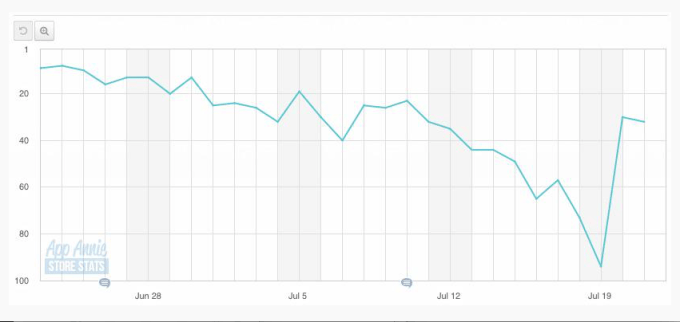
In some cases, their adjusted ranking represented only a small to medium-sized move – like say, just a few slots or as many as 10 slots lower or higher than before, to cite a couple of examples. Another said they returned to their exact same prior rank after the fluctuations stopped.
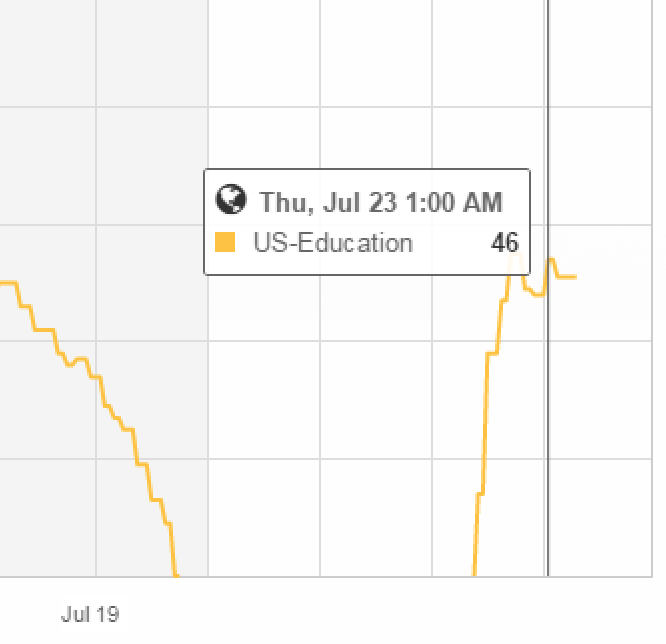
However, some developers saw much larger moves that stuck. For instance, one app moved up nearly 200 spots, then stabilized later in the week with a ranking that was nearly 50 spots higher than before.
Some developers also reported other odd behavior after the fluctuations, including impacts to their keyword rankings and top grossing chart rankings. For instance, one developer who had one of their best sales day ever thanks to a promotion they were running found they had fallen out of the Top Grossing charts after the algorithm change.
Others said that keywords they used to rank for now no longer pulled up their app in search at all, or they saw a significant drop in their popular keywords after the changes. Others still saw that different keywords or keyword combinations were working better or worse than before.
As to why some developers were less affected than others? One guess is because the algorithm adjustment was specifically focused on targeting those who were marketing their apps in a particular way.
For example, some use keyword optimization (ASO or App Store Optimization), while others rely on paid promotions or ads. If Apple only focused on some subset of these methods when making its adjustments, it follows that only some subset of apps would be affected long-term following the change.
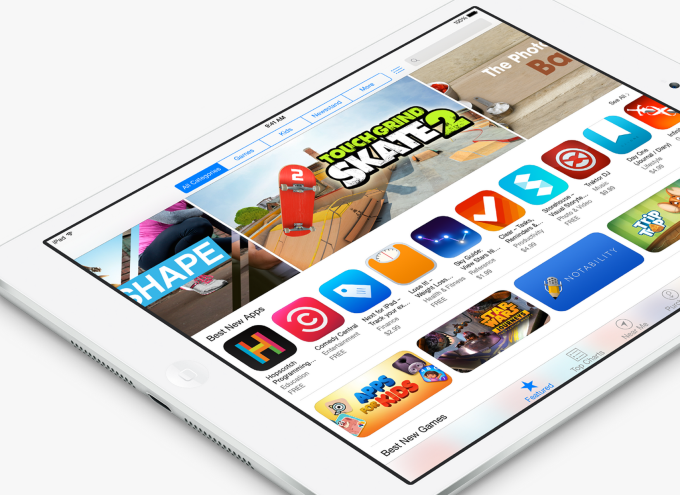
Explains Dan Held, the co-founder at mobile development firm Analytica, there are many reasons Apple might have made an adjustment like this.
While a specific purpose behind this change may be hard to determine (unless Apple comments, which it has not), generally speaking, this change seems to be related to ranking factors, not closing down a hole, Held believes.
“The purpose of the change is to more accurately rank apps based on criteria Apple deems ‘quality.’ They might have found a large exploit some app developers were taking advantage of, but this seems more like a very large change of what Apple sees as important ranking factors – reviews, downloads, keywords, etc.,” he says.
At the end of the day, what’s most interesting about this particular change is that it much more heavily affected iPad applications, instead of iPhone apps. Though there are some examples of iPhone apps being impacted, the biggest movements both during and after the adjustments were among those apps built for iPad. That could indicate that Apple was looking to better its rankings for those who are building specifically for Apple’s tablet, and possibly rewarding the better iPad apps in the process.
